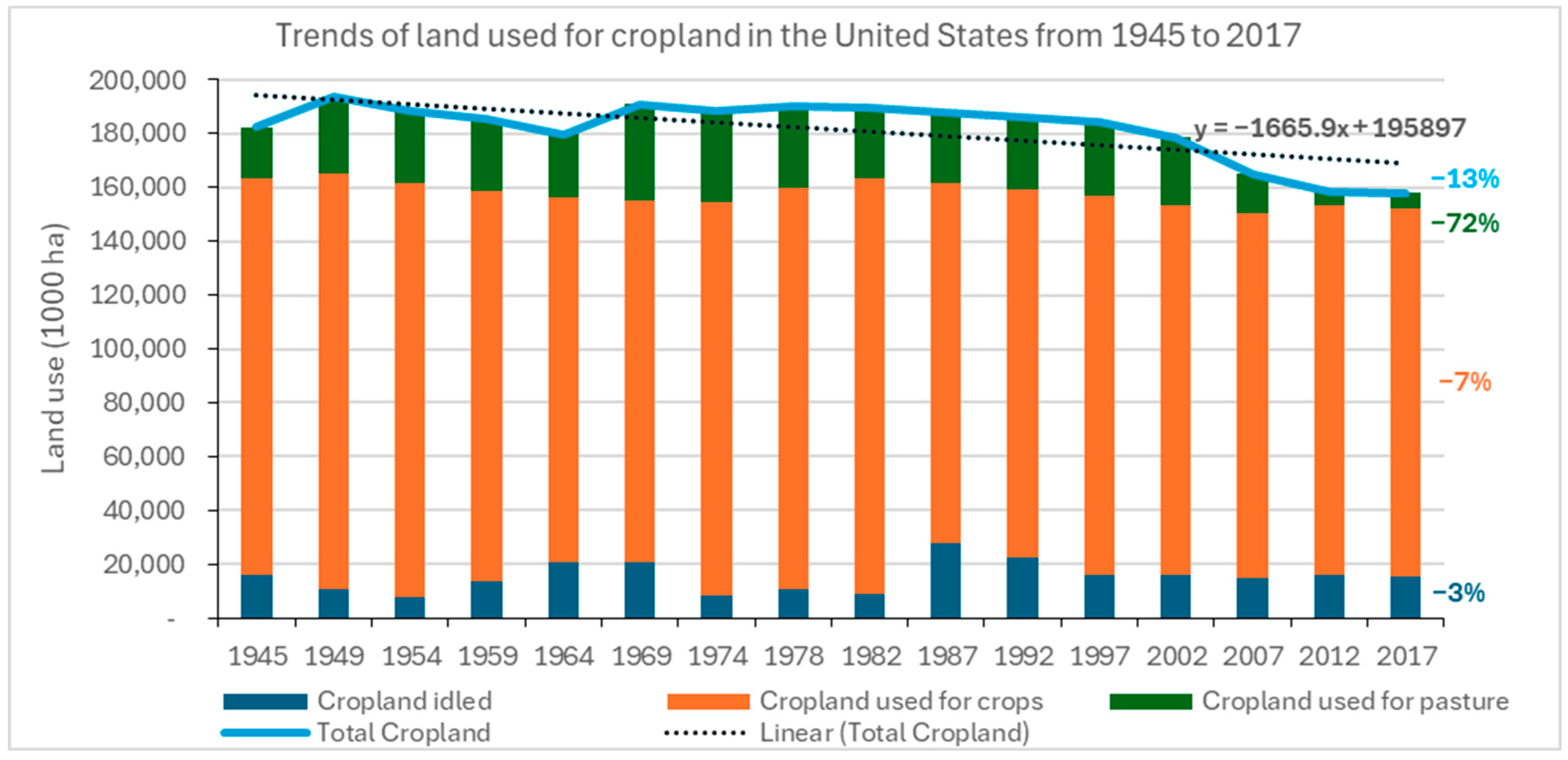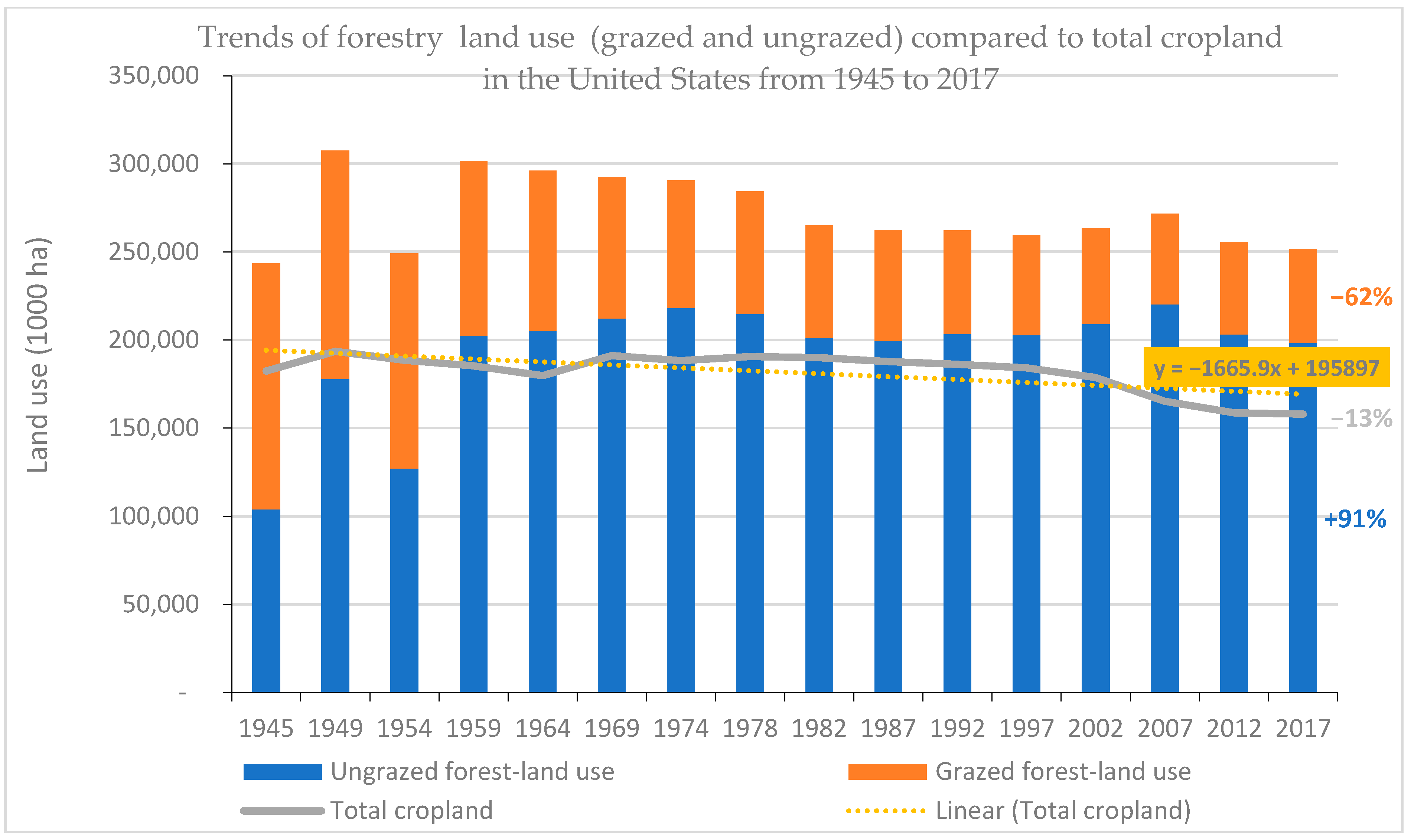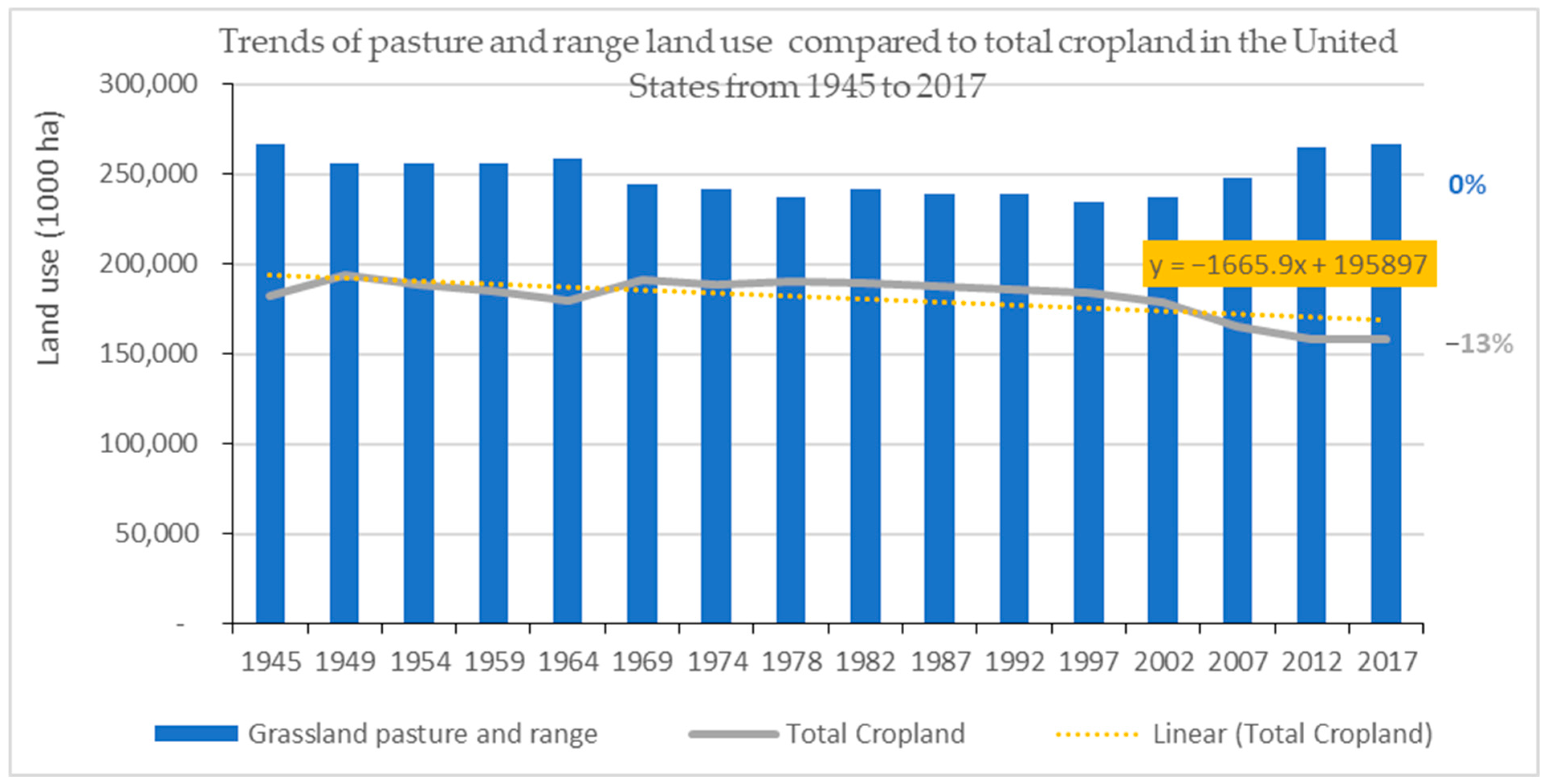Cropland, Competing Land Use, and Food Security Implications: Seven-Decade Case Analysis of USA
Abstract
1. Introduction
2. Materials and Methods
2.1. Study Area and Scope
2.2. Data Source
2.3. Land Use Types Based on the USDA Census of Agriculture
2.4. Data Curation and Analysis
3. Results and Discussion
3.1. Cropland Use Trends in the United States
3.2. Factors Driving Total Cropland Decline in the United States
3.2.1. Competing Land Use
Rural Development
Farmstead and Miscellaneous Land Use
Natural Resources Conservation
Urbanization and Industrialization
3.2.2. Agricultural Technology and Innovation Improvements
3.2.3. Climate Change
3.2.4. Government Economic Policies
3.2.5. Population Growth and Food Security
4. Concluding Remarks
Author Contributions
Funding
Institutional Review Board Statement
Informed Consent Statement
Data Availability Statement
Acknowledgments
Conflicts of Interest
References
- Lambin, E.F.; Geist, H.J.; Lepers, E. Dynamics of land-use and land-cover change in tropical regions. Annu. Rev. Environ. Resour. 2001, 28, 205–241. [Google Scholar] [CrossRef]
- USDA, Economic Research Services. Agricultural Productivity in the United States. 2024. Available online: https://www.ers.usda.gov/data-products/agricultural-productivity-in-the-united-states/summary-of-recent-findings (accessed on 22 March 2025).
- Waisanen, P.J.; Bliss, N.B. Changes in population and agricultural land in conterminous United States counties, 1790 to 1997. Glob. Biogeochem. Cycles 2002, 16, 84-1–84-19. [Google Scholar] [CrossRef]
- Brown, D.G.; Johnson, K.M.; Loveland, T.R.; Theobald, D.M. Rural land-use trends in the conterminous United States, 1950–2000. Ecol. Appl. 2005, 15, 1851–1863. [Google Scholar] [CrossRef]
- FAO. The State of the World’s Land and Water Resources for Food and Agriculture (SOLAW)—Managing Systems at Risk; FAO: Rome, Italy, 2011. [Google Scholar]
- Sorensen, A.; Freedgood, J.; Dempsey, J.; Theobald, D. Farms Under Threat: The State of America’s Farmland; American Farmland Trust: Washington, DC, USA, 2018. [Google Scholar]
- D’Odorico, P.; Carr, J.A.; Laio, F.; Ridolfi, L.; Vandoni, S. Feeding humanity through global food trade. Earth’s Future 2014, 2, 458–469. [Google Scholar] [CrossRef]
- Lark, T.J.; Spawn, S.A.; Bougie, M.; Gibbs, H.K. Cropland expansion in the United States produces marginal yields at high costs to wildlife. Nat. Commun. 2020, 11, 4295. [Google Scholar] [CrossRef]
- Lark, T.J.; Hendricks, N.P.; Smith, A.; Pates, N.; Spawn-Lee, S.A.; Bougie, M.; Booth, E.G.; Kucharik, C.J.; Gibbs, H.K. Environmental outcomes of the US Renewable Fuel Standard. Proc. Natl. Acad. Sci. USA 2022, 119, e2101084119. [Google Scholar] [CrossRef]
- Durán, A.P.; Duffy, J.; Gaston, K.J. Exclusion of agricultural lands in spatial conservation prioritization strategies: Consequences for biodiversity and ecosystem service representation. Proc. R. Soc. B Boil. Sci. 2014, 281, 20141529. [Google Scholar] [CrossRef]
- Scherr, S.J.; McNeely, J.A. Biodiversity conservation and agricultural sustainability: Towards a new paradigm of ‘ecoagriculture’ landscapes. Philos. Trans. R. Soc. B Biol. Sci. 2007, 363, 477–494. [Google Scholar] [CrossRef] [PubMed]
- Mpanga, I.K.; Neumann, G.; Schuch, U.K.; Schalau, J. Sustainable Agriculture Practices as a Driver for Increased Harvested Cropland Among Large-scale Growers in Arizona: A Paradox for Small-scale Growers. Adv. Sustain. Syst. 2020, 4, 1900143. [Google Scholar] [CrossRef]
- USDA—ERS. Farming and Farm Income. 2025. Available online: https://www.ers.usda.gov/data-products/ag-and-food-statistics-charting-the-essentials/farming-and-farm-income (accessed on 10 September 2025).
- Radeloff, V.C.; Helmers, D.P.; Kramer, H.A.; Mockrin, M.H.; Alexandre, P.M.; Bar-Massada, A.; Butsic, V.; Hawbaker, T.J.; Martinuzzi, S.; Syphard, A.D. Rapid growth of the US wildland-urban interface raises wildfire risk. Proc. Natl. Acad. Sci. USA 2018, 115, 3314–3319. [Google Scholar] [CrossRef] [PubMed]
- Foley, J.A.; Defries, R.; Asner, G.P.; Barford, C.; Bonan, G.; Carpenter, S.R.; Snyder, P.K. Global consequences of land use. Science 2005, 309, 570–574. [Google Scholar] [CrossRef] [PubMed]
- Seto, K.C.; Güneralp, B.; Hutyra, L.R. Global forecasts of urban expansion to 2030 and direct impacts on biodiversity and carbon pools. Proc. Natl. Acad. Sci. USA 2012, 109, 16083–16088. [Google Scholar] [CrossRef]
- United Nations, Department of Economic and Social Affairs. Population Division (2019). World Population Prospects; Comprehensive Tables; United Nations: New York, NY, USA, 2019; Volume I.
- Angel, S.; Parent, J.; Civco, D.L.; Blei, A.; Potere, D. The dimensions of global urban expansion: Estimates and projections for all countries, 2000–2050. Prog. Plan. 2011, 75, 53–107. [Google Scholar] [CrossRef]
- Seto, K.C.; Fragkias, M.; Güneralp, B.; Reilly, M.K. A Meta-Analysis of Global Urban Land Expansion. PLoS ONE 2011, 6, e23777. [Google Scholar] [CrossRef] [PubMed]
- Huang, Q.; Liu, Z.; He, C.; Gou, S.; Bai, Y.; Wang, Y.; Shen, M. The occupation of cropland by global urban expansion from 1992 to 2016 and its implications. Environ. Res. Lett. 2020, 15, 084037. [Google Scholar] [CrossRef]
- Bren D’Amour, C.; Reitsma, F.; Baiocchi, G.; Barthel, S.; Güneralp, B.; Erb, K.-H.; Haberl, H.; Creutzig, F.; Seto, K.C. Future urban land expansion and implications for global croplands. Proc. Natl. Acad. Sci. USA 2017, 114, 8939–8944. [Google Scholar] [CrossRef] [PubMed]
- Chen, G.; Li, X.; Liu, X.; Chen, Y.; Liang, X.; Leng, J.; Xu, X.; Liao, W.; Qiu, Y.; Wu, Q. Global projections of future urban land expansion under shared socioeconomic pathways. Nat. Commun. 2020, 11, 537. [Google Scholar] [CrossRef] [PubMed]
- IPCC. Climate Change (2014): Synthesis Report. Contribution of Working Groups I, II and III to the Fifth Assessment Report of the Intergovernmental Panel on Climate Change; IPCC: Geneva, Switzerland, 2014. [Google Scholar]
- Hansen, J.; Sato, M.; Ruedy, R. Global temperature in 2017. Earth Space Sci. 2018, 5, 40–46. [Google Scholar]
- Myers, N. Environmental refugees: A growing phenomenon of the 21st century. Philos. Trans. R. Soc. B Biol. Sci. 2002, 357, 609–613. [Google Scholar] [CrossRef]
- Xie, Y.; Spawn-Lee, S.A.; Radeloff, V.C.; Yin, H.; Robertson, G.P.; Lark, T.J. Cropland abandonment between 1986 and 2018 across the United States: Spatiotemporal patterns and current land uses. Environ. Res. Lett. 2024, 19, 044009. [Google Scholar] [CrossRef]
- Mpanga, I.K.; Omololu, J.I. A decade of irrigation water use trends in Southwest USA: The role of irrigation technology, best management practices, and outreach education programs. Agric. Water Manag. 2021, 243, 106438. [Google Scholar] [CrossRef]
- Turner, B.L.; Lambin, E.F.; Reenberg, A. The emergence of land change science for global environmental change and sustainability. Proc. Natl. Acad. Sci. USA 2007, 104, 20666–20671. [Google Scholar] [CrossRef]
- Fuglie, K.; Jelliffe, J.; Morgan, S. Slowing Productivity Reduces Growth in Global Agricultural Output; USDA, Economic Research Service: Washington, DC, USA, 2024.
- Lawler, J.J.; Lewis, D.J.; Nelson, E.; Plantinga, A.J.; Polasky, S.; Withey, J.C.; Helmers, D.P.; Martinuzzi, S.; Pennington, D.; Radeloff, V.C. Projected land-use change impacts on ecosystem services in the United States. Proc. Natl. Acad. Sci. USA 2014, 111, 7492–7497. [Google Scholar] [CrossRef]
- Spangler, K.; Burchfield, E.K.; Schumacher, B. Past and Current Dynamics of U.S. Agricultural Land Use and Policy. Front. Sustain. Food Syst. 2020, 4, 98. [Google Scholar] [CrossRef]
- USDA—ERS. Major Land Uses. Major Land Uses | Economic Research Service. 2025. Available online: https://www.ers.usda.gov/data-products/major-land-uses (accessed on 20 April 2025).
- Winters-Michaud, C.; Haro, A.; Callahan, S.; Bigelow, D.P. Major Uses of Land in the United States, 2017 (Report No. EIB-275); U.S. Department of Agriculture, Economic Research Service: Washington, DC, USA, 2024.
- Bigelow, D.; Borchers, A. Major Uses of Land in the United States, 2012 (Report No. EIB-178); U.S. Department of Agriculture, Economic Research Service: Washington, DC, USA, 2017.
- Nickerson, C.; Ebel, R.; Borchers, A.; Carriazo, F. Major Land Uses in the United States, 2007; Economic Research Service, Economic Information Bulletin 89; U.S. Department of Agriculture: Washington, DC, USA, 2011.
- USDA—ERS. Population and Migration. 2025. Available online: https://www.ers.usda.gov/topics/rural-economy-population/population-migration (accessed on 10 September 2025).
- Farrigan, T.; Genetin, B.; Sanders, A.; Pender, J.; Thomas, K.L.; Winkler, R.; Cromartie, J. Rural America at a Glance: 2024 Edition (Report No. EIB-282); U.S. Department of Agriculture, Economic Research Service: Washington, DC, USA, 2024.
- Cao, Y.; Zhou, Z.; Liao, Q.; Shen, S.; Wang, W.; Xiao, P.; Liao, J. Effects of landscape conservation on the ecohydrological and water quality functions and services and their driving factors. Sci. Total Environ. 2023, 861, 160695. [Google Scholar] [CrossRef] [PubMed]
- Xie, Y.; Hunter, M.; Sorensen, A.; Nogeire-McRae, T.; Murphy, R.; Suraci, J.P.; Lischka, S.; Lark, T.J. U.S. Farmland under Threat of Urbanization: Future Development Scenarios to 2040. Land 2023, 12, 574. [Google Scholar] [CrossRef]
- Belous, N.M.; Vaskin, V.F.; Kuzmitskaya, A.A.; Kubyshkin, A.V.; Schmidt, Y.I. Dynamics of crop production and rational use of agricultural lands. In Proceedings of the IOP Conference Series: Earth and Environmental Science, Krasnoyarsk, Russia, 17–19 November 2021; IOP Publishing: Bristol, UK, 2022; Volume 981, p. 042009. [Google Scholar] [CrossRef]
- Lark, T.J.; Salmon, J.M.; Gibbs, H.K. Cropland expansion outpaces agricultural and biofuel policies in the United States. Environ. Res. Lett. 2015, 10, 044003. [Google Scholar] [CrossRef]
- Spawn, S.A.; Lark, T.J.; Gibbs, H.K. Carbon emissions from cropland expansion in the United States. Environ. Res. Lett. 2019, 14, 045009. [Google Scholar] [CrossRef]
- Liu, J.; Zeng, S.; Ma, J.; Chang, Y.; Sun, Y.; Chen, F. The Impacts of Rapid Urbanization on Farmland Marginalization: A Case Study of the Yangtze River Delta, China. Agriculture 2022, 12, 1276. [Google Scholar] [CrossRef]
- Schillinger, W.F.; Papendick, R.I.; Guy, S.O.; Rasmussen, P.E.; Van Kessel, C. Dryland Cropping in the Western United States: Dryland Agriculture. In Agronomy Monograph No. 23, 2nd ed.; American Society of Agronomy: Madison, MI, USA; Crop Science Society of America: Madison, MI, USA; Soil Science Society of America Journal: Madison, MI, USA, 2006. [Google Scholar] [CrossRef]
- Munn, I.A.; Barlow, S.A.; Evans, D.L.; Cleaves, D. Urbanization’s impact on timber harvesting in the south central United States. J. Environ. Manag. 2002, 64, 65–76. [Google Scholar] [CrossRef]
- Clement, M.T.; Chi, G.; Ho, H.C. Urbanization and Land-Use Change: A Human Ecology of Deforestation Across the United States, 2001–2006. Sociol. Inq. 2015, 85, 628–653. [Google Scholar] [CrossRef]
- Crookston, R.K. A Top 10 List of Developments and Issues Impacting Crop Management and Ecology During the Past 50 Years. Crop Sci. 2006, 46, 2253–2262. [Google Scholar] [CrossRef]
- Hanson, J.D.; Hendrickson, J.; Archer, D. Challenges for maintaining sustainable agricultural systems in the United States. Renew. Agric. Food Syst. 2008, 23, 325–334. [Google Scholar] [CrossRef]
- Lubowski, R.N.; Bucholtz, S.; Claassen, R.; Roberts, M.; Cooper, J.; Gueorguieva, A.; Johansson, R. Environmental Effects of Agricultural Land-Use Change: The Role of Economics and Policy; ERR-25; U.S. Department of Agriculture, Economic Research Service: Washington, DC, USA, 2006.
- USDA. 2023. Available online: www.ers.usda.gov/data-products/chart-gallery/gallery/chart-detail/?chartId=106637 (accessed on 10 September 2025).
- Stone, B. Developments in Agricultural Technology; Cambridge University Press: Cambridge, UK, 1988. [Google Scholar] [CrossRef]
- Food and Agriculture Organization (FAO). Scaling Conservation Agriculture: Policy Implications for Climate-Resilient Farming; FAO: Rome, Italy, 2021. [Google Scholar]
- Mpanga, I.K.; Schuch, K.U.; Schalau, J. Adaptation of resilient regenerative agricultural practices by small-scale growers towards sustainable food production in north-central Arizona. Curr. Res. Environ. Sustain. 2021, 3, 100067. [Google Scholar] [CrossRef]
- Chimwamurombe, P.M.; Mataranyika, P.N. Factors influencing dryland agricultural productivity. J. Arid. Environ. 2021, 189, 104489. [Google Scholar] [CrossRef]
- Crossley, M.S.; Burke, K.D.; Schoville, S.D.; Radeloff, V.C. Recent collapse of crop belts and declining diversity of US agriculture since 1840. Glob. Change Biol. 2021, 27, 151–164. [Google Scholar] [CrossRef]
- Kim, S.M.; Mendelsohn, R. Climate change to increase crop failure in U.S. Environ. Res. Lett. 2023, 18, 014014. [Google Scholar] [CrossRef]
- Petersen, L.K. Impact of Climate Change on Twenty-First Century Crop Yields in the U.S. Climate 2019, 7, 40. [Google Scholar] [CrossRef]
- Baskaran, R.; Karunakaran, V.; Pandiyan, M. Climate change on crop production. J. Pharmacogn. Phytochem. 2019, SP2, 744–748. [Google Scholar]
- USDA—ERS. Risk Management—Risk in Agriculture. 2025. Available online: https://www.ers.usda.gov/topics/farm-practices-management/risk-management/risk-in-agriculture (accessed on 20 April 2025).
- Glauber, J.W.; Effland, A. United States Agricultural Policy: Its Evolution and Impact (20 July 2016). IFPRI Discussion Paper 1543. Available online: https://ssrn.com/abstract=2813385 (accessed on 10 September 2025).
- Worldometer. World Population Clock: 8.24 Billion People. 2025. Available online: https://www.worldometers.info/world-population/ (accessed on 10 August 2025).
- United Nations. World Population Prospects. Department of Economic and Social Affairs, Population Division. 2024. Available online: https://population.un.org/wpp/ (accessed on 10 August 2025).
- Yadav, A.; Yadav, T.K. Study of population growth and land use change impacts on socio economic conditions. Int. J. Innov. Res. Anal. (IJIRA) 2024, 4, 258–262. [Google Scholar]
- Fuglie, K.; Morgan, S.; Jelliffe, J. World Agricultural Production, Resource Use, and Productivity, 1961–2020; EIB-268; U.S. Department of Agriculture, Economic Research Service: Washington, DC, USA, 2024.







| Land Use Types | Sub-Categories of Land Use |
|---|---|
| Crop land | Cropland used for crops |
| Cropland idle | |
| Cropland used for pasture | |
| Farmstead, roads and miscellaneous land | Farmsteads and roads |
| Other miscellaneous land | |
| Rural land | Land in rural parks and wildlife areas |
| Land used in rural transportation facilities | |
| Urban and industrial land | Land in urban areas |
| Land in defense and industrial areas | |
| Forest and pastureland | Ungrazed forest-land use |
| Grazed forest-land use | |
| Grassland pasture and range |
Disclaimer/Publisher’s Note: The statements, opinions and data contained in all publications are solely those of the individual author(s) and contributor(s) and not of MDPI and/or the editor(s). MDPI and/or the editor(s) disclaim responsibility for any injury to people or property resulting from any ideas, methods, instructions or products referred to in the content. |
© 2025 by the authors. Licensee MDPI, Basel, Switzerland. This article is an open access article distributed under the terms and conditions of the Creative Commons Attribution (CC BY) license (https://creativecommons.org/licenses/by/4.0/).
Share and Cite
Mpanga, I.K.; Koomson, E. Cropland, Competing Land Use, and Food Security Implications: Seven-Decade Case Analysis of USA. Sustainability 2025, 17, 8352. https://doi.org/10.3390/su17188352
Mpanga IK, Koomson E. Cropland, Competing Land Use, and Food Security Implications: Seven-Decade Case Analysis of USA. Sustainability. 2025; 17(18):8352. https://doi.org/10.3390/su17188352
Chicago/Turabian StyleMpanga, Isaac Kwadwo, and Eric Koomson. 2025. "Cropland, Competing Land Use, and Food Security Implications: Seven-Decade Case Analysis of USA" Sustainability 17, no. 18: 8352. https://doi.org/10.3390/su17188352
APA StyleMpanga, I. K., & Koomson, E. (2025). Cropland, Competing Land Use, and Food Security Implications: Seven-Decade Case Analysis of USA. Sustainability, 17(18), 8352. https://doi.org/10.3390/su17188352







